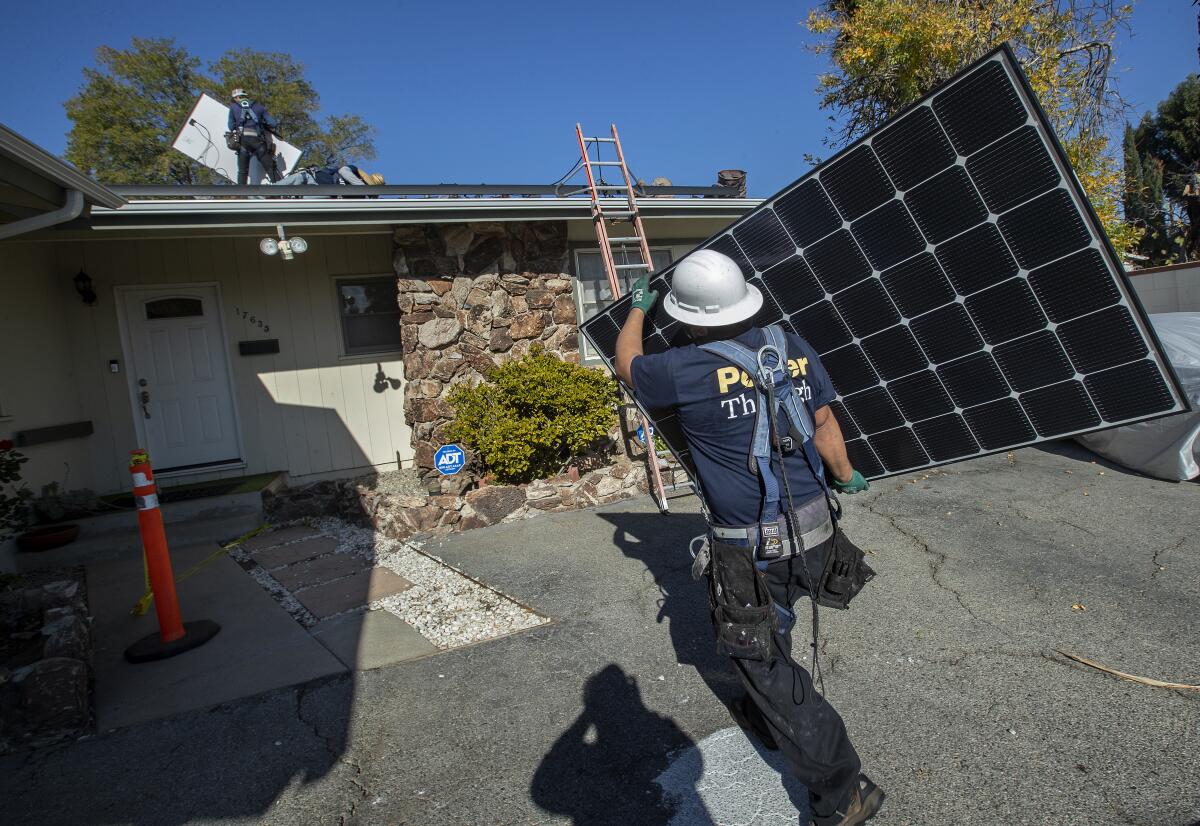The Inflation Reduction Act passed in 2022. Why are states lagging behind on energy rebates?

- Share via
There may not be much public awareness that the Inflation Reduction Act is the biggest investment in clean energy and climate action in U.S. history, but its consumer incentives are sure proving to be popular.
American households claimed more than $8 billion in Inflation Reduction Act tax credits last year for clean energy and energy efficiency upgrades such as solar panels, heat pumps and home insulation, exceeding expectations for the 2022 law, according to recently released Treasury Department data.
It’s great news that millions of Americans are taking advantage of these generous tax credits, and a hopeful sign that the clean energy transformation envisioned under President Biden’s landmark 2022 legislation is off to a good start.
Monday is the first day of class for students at L.A. Unified and other schools around California. Too many kids face hot classrooms that lack adequate cooling.
But we’re less thrilled that another incentive in the law, home energy rebates, are still largely unavailable. They have been slower to roll out because they’re being distributed at the state level, and so far only a handful, including New York and Wisconsin, have launched their programs.
Dozens of other states are in different stages in the application process. Several, including California, have had their applications approved but are still setting up their programs. It’s time for those states and the U.S. Department of Energy to pick up the pace and get these rebate programs up and running so Americans of all income levels can start to benefit.
Unlike tax credits, which are applied to investments that have already been made, the rebates are applied at the point of sale. That will help more people participate because they won’t have to wait for their tax refunds to benefit. And it’s important to get these programs going as soon as possible so that people whose appliances break can replace them with zero-emission models that will immediately pay off in energy savings and cleaner air.
California’s ban on single-use plastic grocery bags worked. But it inadvertently created a new plastic problem — those supposedly reusable and recyclable thicker bags that simply replaced the thinner versions.
California will get nearly $600 million in IRA home energy rebates, with the first program expected to launch in September.
One program provides low and moderate-income households with point-of-sale rebates to purchase and install energy efficient appliances, including up to $840 toward an electric induction stove or clothes dryer, $1,750 for a heat pump water heater, $8,000 for a heat pump heating and cooling system and for home insulation, an electrical panel and wiring upgrades, up to a total of $14,000. Another program offers thousands of dollars off whole house retrofit projects that slash energy use, but isn’t expected to launch until mid-2025.
Getting these rebate programs online quickly is not just a climate imperative, but a fairness issue. The Inflation Reduction Act put more than $390 million toward clean energy and climate action, much of it in the form of tax credits for businesses and consumers.
But tax credits are skewed toward homeowners and wealthier people, and less accessible to lower-income people who rent, can’t afford to pay for these projects upfront or don’t owe enough taxes to benefit. Upfront rebates are a critical way to extend savings to a wider swath of Americans.
Editorial: Trump and oil companies are lying to you about electric cars to serve their own interests
There is no federal ban on gas-powered cars. Trump and the oil companies are pushing that lie for their own self-serving agendas.
They’re also more tangible for many Americans because they apply to the machines and appliances used every day. They will help people replace old gas stoves, dryers, furnaces and water heaters with more efficient electric models that don’t pollute the air and warm the planet, and install rooftop solar panels that will slash their monthly electric bills.
Once the rebate programs are in place, states must make it easy to access them and educate the public about their availability. That means working with contractors, retailers and electric utilities to get the word out and make the experience of determining eligibility for home appliance and other energy incentives as streamlined and friction-free as possible.
It’s time to get these programs into gear so all Americans can participate in the clean energy revolution.
More to Read
A cure for the common opinion
Get thought-provoking perspectives with our weekly newsletter.
You may occasionally receive promotional content from the Los Angeles Times.












